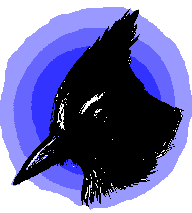Adapted from Jim Conrad's online book A Birding Trip through Mexico, This excerpt from "The Pine Forest of Lake Arareko" near Copper Canyon
STELLER'S JAYS A shrill, sassy shack-shack-shack erupts from the little valley below. I go there and find three or four Steller's Jays orbiting around one another as the flock drifts among the pines' mid-level branches. Steller's Jays are well known in western North America because they are so loud, colorful, and don't mind living near humans. In the East our Blue Jays look a little similar, and behave in the same aggressive, flamboyant manner. The favorite food of Steller's Jays is acorns, but in this oakless forest they are content to flit from one half-open pine cone to another, with their big bills probing for pine seed not yet fallen to the ground.
A shrill, sassy shack-shack-shack erupts from the little valley below. I go there and find three or four Steller's Jays orbiting around one another as the flock drifts among the pines' mid-level branches. Steller's Jays are well known in western North America because they are so loud, colorful, and don't mind living near humans. In the East our Blue Jays look a little similar, and behave in the same aggressive, flamboyant manner. The favorite food of Steller's Jays is acorns, but in this oakless forest they are content to flit from one half-open pine cone to another, with their big bills probing for pine seed not yet fallen to the ground.
A jay lands on a branch, spots me, does a double-take, bounces to a more open spot on the limb, bends toward me so far he seems about to fall, looks at me with his right eye, and then, with a theatrical flourish of wings and tail, snaps his head about to look at me with his left eye. This head-turning goes on for a couple of minutes, each turn his long, black crest flopping clownishly and prettily in the crisp morning air. Then a second jay lands nearby, the gawker turns and looks at his visitor, appears to decide that this second jay should be avoided, and instantly flees deep inside a neighboring pine.
The second jay, though I am in plain view, simply ignores me. I decide that maybe it hasn't discovered me so I clap my hands just to see what its reaction will be. It pauses and for ten seconds -- without moving a feather -- stares at me as penetratingly as a bird can manage. Then it continues ignoring me. It begins probing for pine seeds making no superfluous moves at all. This bird's crest concisely expresses certain levels of interest in this and that, but by no means does it flop. I admire its economy of motion, the way it appears to think out its foraging plan beforehand, and how frequently it finds something to eat. This bird projects a regal image just opposite to the first one's.